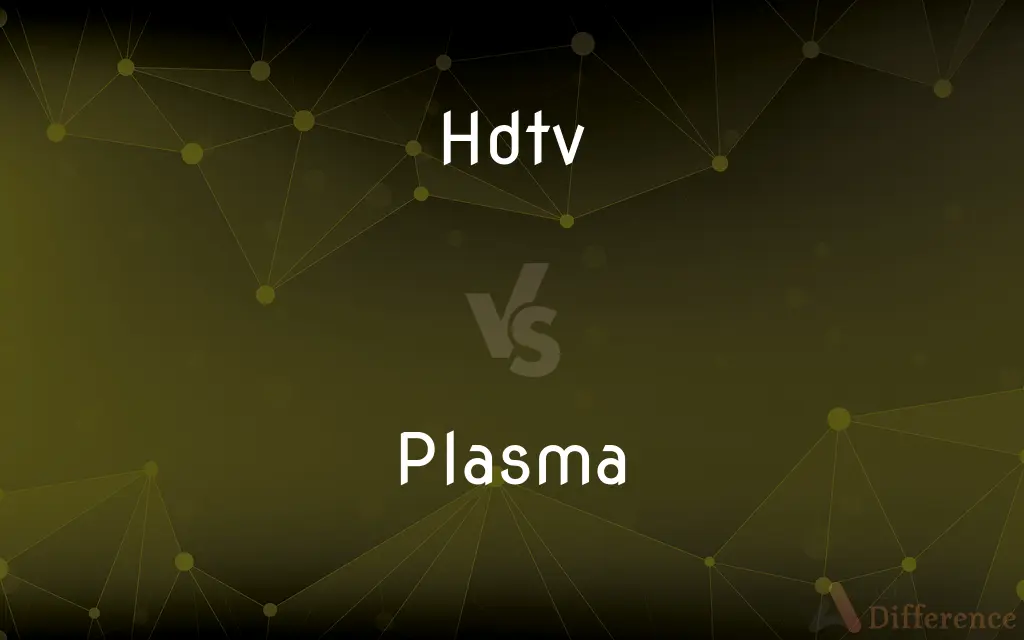HDTV vs. Plasma — What's the Difference?
Edited by Tayyaba Rehman — By Fiza Rafique — Updated on May 20, 2024
HDTV (High Definition Television) refers to a resolution standard for televisions, while Plasma refers to a type of display technology used in TVs.

Difference Between HDTV and Plasma
Table of Contents
ADVERTISEMENT
Key Differences
HDTV stands for High Definition Television, a resolution standard that offers higher quality images compared to standard definition. It includes resolutions such as 720p, 1080i, and 1080p, providing clearer and more detailed pictures. Plasma TVs, on the other hand, are a type of display technology that uses small cells containing electrically charged ionized gases to produce images.
HDTV technology focuses on the resolution and clarity of the content being displayed, independent of the display technology. It ensures a high-quality viewing experience with more pixels, resulting in better detail and sharpness. Plasma technology, in contrast, deals with how the image is produced on the screen, offering benefits in picture quality, especially for darker scenes and fast motion.
While HDTV is a standard adopted by various display technologies to enhance image resolution, Plasma is a specific type of display that can utilize HDTV resolutions to produce its superior images. Over time, Plasma TVs have largely been phased out in favor of more energy-efficient and thinner LED and OLED displays that also support HDTV standards.
HDTV defines the resolution quality of television content, while Plasma refers to a display technology known for excellent picture quality but now largely replaced by more modern activities.
Comparison Chart
Definition
High Definition Television standard
Display technology using ionized gases
ADVERTISEMENT
Focus
Resolution and clarity of images
Picture quality and display characteristics
Common Resolutions
720p, 1080i, 1080p
Supports HDTV resolutions like 720p, 1080p
Technology Types
LCD, LED, OLED, Plasma
Specific to Plasma displays
Image Quality
High resolution with clear details
Superior color accuracy and deeper blacks
Power Consumption
Generally lower with modern displays
Higher power consumption
Screen Burn-in
Not typically an issue
Susceptible to burn-in
Viewing Angles
Varies by display type
Generally wide viewing angles
Weight and Thickness
Varies by display type
Heavier and thicker
Current Use
Standard for modern TVs
Largely phased out
Compare with Definitions
Hdtv
Typically features 720p, 1080i, or 1080p resolution.
My new TV supports 1080p HDTV for crystal-clear movies.
Plasma
Typically has wider viewing angles compared to early LCDs.
The plasma screen allowed us to watch from any angle in the room.
Hdtv
Enhances viewing experience with more pixels and better image quality.
HDTV broadcasts make nature documentaries look stunning.
Plasma
Susceptible to screen burn-in with static images.
Leaving a static image on a plasma TV can cause burn-in.
Hdtv
A television format that provides higher resolution than standard definition.
Watching sports in HDTV provides a much clearer and more detailed picture.
Plasma
Known for superior color accuracy and deeper blacks.
My old plasma TV had amazing colors, especially for movies.
Hdtv
Can be displayed on various types of screens.
Both LED and OLED TVs can display HDTV content.
Plasma
The clear, yellowish fluid portion of blood, lymph, or intramuscular fluid in which cells are suspended. It differs from serum in that it contains fibrin and other soluble clotting elements.
Hdtv
Standard for modern television content.
Most TV channels now broadcast in HDTV.
Plasma
Blood plasma, especially when sterilized and depleted of cells for transfusion.
Hdtv
A television system that has more than the usual number of lines per frame so its pictures show more detail
Plasma
Protoplasm or cytoplasm.
Plasma
The fluid portion of milk from which the curd has been separated by coagulation; whey.
Plasma
(Physics) An electrically neutral, highly ionized phase of matter composed of ions, electrons, and neutral particles. It is distinct from solids, liquids, and gases.
Plasma
Of or relating to a flat-panel display used in televisions, made up of an array of tiny cells each containing a gaseous mixture of xenon and neon that is changed into a plasma state to illuminate a phosphor coating on the inside of the cell.
Plasma
(physics) A state of matter consisting of partially ionized gas and electrons.
Plasma
(hematology) A clear component of blood or lymph containing fibrin.
Plasma
(hematology) Blood plasma, free of suspended cells, used in transfusions.
Plasma
(mineralogy) A variety of green quartz, used in ancient times for making engraved ornaments.
Plasma
A mixture of starch and glycerin, used as a substitute for ointments.
Plasma
A visual effect in which cycles of changing colours are warped in various ways to give the illusion of liquid organic movement.
Plasma
A variety of quartz, of a color between grass green and leek green, which is found associated with common chalcedony. It was much esteemed by the ancients for making engraved ornaments.
Plasma
The viscous material of an animal or vegetable cell, out of which the various tissues are formed by a process of differentiation; protoplasm.
Plasma
Unorganized material; elementary matter.
Plasma
A mixture of starch and glycerin, used as a substitute for ointments.
Plasma
Same as blood plasma.
Plasma
A state of matter in which charged particles such as electrons and atomi nuclei have sufficiently high energy to move freely, rather than be bound in atoms as in ordinary matter; it has some of the properties of a gas, but is a conductor of electricity.
Plasma
Colorless watery fluid of blood and lymph containing no cells and in which erythrocytes and leukocytes and platelets are suspended
Plasma
A green slightly translucent variety of chalcedony used as a gemstone
Plasma
(physical chemistry) a fourth state of matter distinct from solid or liquid or gas and present in stars and fusion reactors; a gas becomes a plasma when it is heated until the atoms lose all their electrons, leaving a highly electrified collection of nuclei and free electrons;
Particles in space exist in the form of a plasma
Plasma
A type of TV display technology using ionized gas cells.
Plasma TVs were popular for their excellent picture quality.
Plasma
Heavier and consumes more power than newer technologies.
Plasma TVs are bulkier and less energy-efficient.
Common Curiosities
What are common HDTV resolutions?
Common HDTV resolutions are 720p, 1080i, and 1080p.
What is HDTV?
HDTV stands for High Definition Television, a standard that offers higher resolution and clearer images compared to standard definition.
What is Plasma TV?
Plasma TV is a type of display technology that uses ionized gas cells to produce images with superior color and contrast.
Are Plasma TVs still being produced?
Plasma TVs have largely been phased out in favor of more energy-efficient and thinner technologies like LED and OLED.
Can HDTV be displayed on any type of screen?
Yes, HDTV can be displayed on various types of screens, including LCD, LED, OLED, and Plasma.
Is there a difference in picture quality between HDTV and Plasma?
HDTV refers to resolution quality, while Plasma refers to display technology. Plasma can display HDTV content with excellent picture quality.
Can Plasma TVs support HDTV resolutions?
Yes, Plasma TVs can support HDTV resolutions like 720p and 1080p.
Is screen burn-in an issue for HDTV?
Screen burn-in is not typically an issue for HDTV itself, but it can be a problem for Plasma displays.
Can Plasma TVs handle fast motion well?
Yes, Plasma TVs handle fast motion very well, making them good for watching sports and action movies.
Do modern TVs support HDTV?
Yes, most modern TVs support HDTV as a standard.
Which technology consumes more power, Plasma or modern displays?
Plasma displays consume more power compared to modern LED and OLED displays.
What advantages did Plasma TVs offer?
Plasma TVs offered superior color accuracy, deeper blacks, and wider viewing angles.
What caused the decline of Plasma TVs?
The decline of Plasma TVs was due to their higher power consumption, thicker and heavier design, and the rise of more efficient technologies like LED and OLED.
Are Plasma TVs heavier than modern LED TVs?
Yes, Plasma TVs are generally heavier and bulkier compared to modern LED TVs.
What should I consider when buying a TV for HDTV content?
When buying a TV for HDTV content, consider the resolution (720p, 1080p), type of display technology (LED, OLED), power consumption, and features like smart capabilities.
Share Your Discovery

Previous Comparison
Neurologist vs. Neurosurgeon
Next Comparison
Katana vs. ScimitarAuthor Spotlight
Written by
Fiza RafiqueFiza Rafique is a skilled content writer at AskDifference.com, where she meticulously refines and enhances written pieces. Drawing from her vast editorial expertise, Fiza ensures clarity, accuracy, and precision in every article. Passionate about language, she continually seeks to elevate the quality of content for readers worldwide.
Edited by
Tayyaba RehmanTayyaba Rehman is a distinguished writer, currently serving as a primary contributor to askdifference.com. As a researcher in semantics and etymology, Tayyaba's passion for the complexity of languages and their distinctions has found a perfect home on the platform. Tayyaba delves into the intricacies of language, distinguishing between commonly confused words and phrases, thereby providing clarity for readers worldwide.
















































